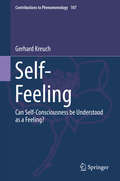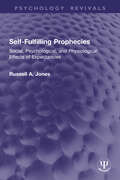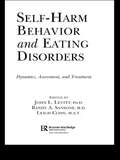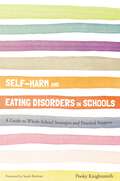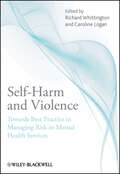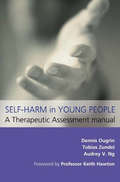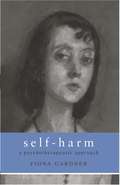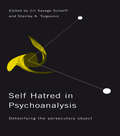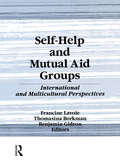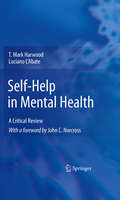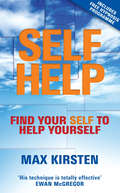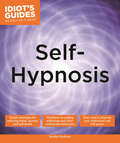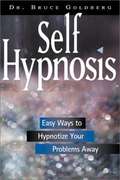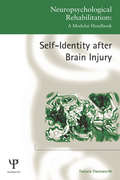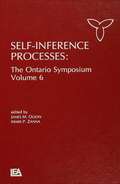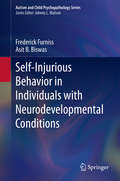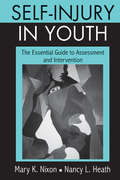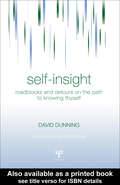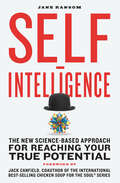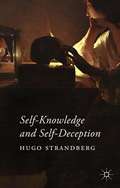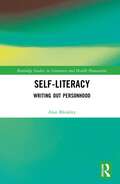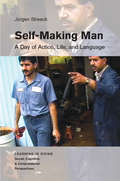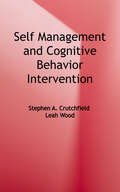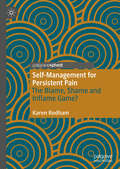- Table View
- List View
Self-Feeling: Can Self-Consciousness be Understood as a Feeling? (Contributions to Phenomenology #107)
by Gerhard KreuchThis monograph offers new insights into the connection between self-consciousness and emotion. It focuses on what fundamental “feelings of being” tell us about ourselves. The results enrich the philosophy of human affectivity and help shed new light on some pressing, current problems. The author seeks to understand self-consciousness as an affective phenomenon, namely as self-feeling. He identifies it as a pre-reflective, pre-propositional, bodily feeling that shapes our space of possibilities. It is the affective disclosure of individual existence. His account overcomes the difficulties of infinite regress and vicious circularity that reflective (or higher-order) accounts of self-consciousness struggle with. At the same time, it helps build a bridge between the basic level of self-consciousness and the higher level of more substantial thoughts about oneself. The title explores fundamental affectivity, Matthew Ratcliffe’s theory of existential feelings, features of self-feeling, and appropriateness and inappropriateness in self-interpretation. It also considers the contributions of the Heidelberg School of self-consciousness to current debates. The title provides students and researchers with a unique look into such vital philosophical questions as: What is self-consciousness? How do we know ourselves? It will also appeal to a wider audience interested in self-consciousness and/or human affectivity since it does not presuppose knowledge of the jargon.
Self-Fulfilling Prophecies: Social, Psychological, and Physiological Effects of Expectancies (Psychology Revivals)
by Russell A. JonesOriginally published in 1977, Self-Fulfilling Prophecies: Social, Psychological, and Physiological Effects of Expectancies integrates a wide variety of research and theory dealing with inter- and intrapersonal expectancies, from which the author develops a new theoretical model. The model explores the relationships between a person’s expectation of success and both the objective probability of success and the effort expended in pursuit of the goal. The author also explores in detail the interdependence of one’s interpersonal expectancies (as in implicit personality theories, stereotypes, and the labeling approach to deviant behavior), and an individual's personal goals. With the development of the theoretical model, the author critically reviews the literature on performance and goal-seeking behavior at the time. Finally, the influences of expectancies on susceptibility to illness, placebo effects, and psychosomatic disease are discussed.This will be a volume of interest to all concerned with human motivation and goal-seeking behavior and today can be read in its historical context.
Self-Harm Behavior and Eating Disorders: Dynamics, Assessment, and Treatment
by Ph. D. Leigh Cohn Randy A. Sansone John L. Levitt M. A. T.The number of eating disorders patients presenting with symptoms of self-harm is growing quickly, and yet there is surprisingly little known about this unique population. Self-Harm Behavior and Eating Disorders explores the prevalent but largely uncharted relationship between self-injury behaviors and eating disorders symptoms. In the first major book to focus on this area, a renowned group of international scholars and practitioners addresses the subject from a variety of theoretical and practical perspectives. The book is categorized into sections covering epidemiology, psychodynamics, assessment, and a final section covering potential treatment options, including dialectical behavioral therapy, cognitive therapy, interventions strategies, group therapy, and pharmacological approaches. This unrivaled collection of case studies, theoretical exploration, and practical application forms a benchmark for the field, and offers a stepping-stone for new research and innovative treatment strategies. In an area with little available information, previously spread out among diffuse sources, this volume represents the state-of-the-field resource for anyone working with complex eating disorders patients.
Self-Harm and Eating Disorders in Schools: A Guide to Whole-School Strategies and Practical Support
by Sarah Brennan Pooky KnightsmithSelf-harm and eating disorders are present in almost every school and they frequently co-occur. This book provides the vital guidance that school staff need to spot early warning signs, understand triggers and support the students in their care effectively. This very practical guide helps educational professionals to gain a better understanding of self-harm and eating disorders by dispelling the myths and misconceptions that surround these behaviours. The book provides advice on whole-school policies and procedures as well as day-to-day strategies to implement in lessons, at mealtimes and in one-on-one sessions. It explains how to respond to disclosures, make referrals and work alongside parents to assist in the road to recovery.
Self-Harm and Eating Disorders in Schools: A Guide to Whole-School Strategies and Practical Support
by Pooky KnightsmithSelf-harm and eating disorders are present in almost every school and they frequently co-occur. This book provides the vital guidance that school staff need to spot early warning signs, understand triggers and support the students in their care effectively.This very practical guide helps educational professionals to gain a better understanding of self-harm and eating disorders by dispelling the myths and misconceptions that surround these behaviours. The book provides advice on whole-school policies and procedures as well as day-to-day strategies to implement in lessons, at mealtimes and in one-on-one sessions. It explains how to respond to disclosures, make referrals and work alongside parents to assist in the road to recovery.
Self-Harm and Violence: Towards Best Practice in Managing Risk in Mental Health Services
by Richard Whittington Caroline LoganSelf-Harm and Violence: Towards Best Practice in Managing Risk in Mental Health Services presents the first exploration of the most effective clinical practice techniques relating to the management of risk in mental health care settings. Based on the Department of Health’s Best Practice in Managing Risk guidance document, which was developed over a 12-month period in consultation with a national expert advisory group Features contributions from many members of the group that drew up the Best Practice document – all leading theoreticians and practitioners in their particular fields – and embeds the principles laid out in the guidelines in real world practice Reveals how contemporary risk management is a multidisciplinary and collaborative enterprise in which practitioners from different professions need to engage with each other in order to achieve success
Self-Harm in Young People: A Therapeutic Assessment Manual
by Dennis Ougrin Tobias Zundel Audrey V NgSelf-harm is a distressing and all too common presentation to emergency departments, and yet there is no clear understanding of what it represents, and success rates of interventions to prevent future episodes are enormously variable.Therapeutic Assessment for self-harm is a pragmatic model, developed by the authors of this book and forming an orga
Self-Harm: A Psychotherapeutic Approach
by Fiona GardnerSelf-harm is worryingly common in young women, and is often used as a way of easing emotional suffering. Self-Harm: A Psychotherapeutic Approach explores the issues involved from the perspective of a psychoanalytical psychotherapist. Fiona Gardner examines these issues through extensive clinical material and an analysis of the social and cultural influences behind self-harm. This book will be of interest to all those working with those who are harming themselves, including psychotherapists, school counsellors, social workers and mental health clinicians.
Self-Hatred in Psychoanalysis: Detoxifying the Persecutory Object
by Jill Savege Scharff Stanley A. TsigounisThe persecutory object is the element of the personality which attacks your confidence, productivity and acceptance to the point of no return. Persecuted patients torture themselves, hurt their loved ones and torment their therapists. In this book, the authors deal with the tenacity of the persecutory object, integrating object relations and Kleinian theories in a way of working with persecutory states of mind. This is vividly illustrated in a variety of situations, including:·individual, couple and group therapy·serious paediatric illness·working with persecutory aspects of family business.It is argued that the persecutory object can be contained, modified, and in many cases detoxified by the process of skilful intensive psychotherapy and psychoanalysis. Self Hatred in Psychoanalysis will be invaluable to a variety of practitioners including psychoanalysts, psychotherapists, social workers, psychiatrists and mental health counsellors.
Self-Help and Mutual Aid Groups: International and Multicultural Perspectives
by Benjamin Gidron Francine LavoieHere is new information on the development of international and intercultural research on self-help groups. This book reflects the many developments which have occurred in the field over the past decade, emphasizing empirical research. Self-Help and Mutual Aid Groups provides specific research findings and honed concepts to help health professionals learn more about self-help groups and work effectively with such groups. More countries and ethnic groups are now involved in the self-help movement, and this volume increases knowledge of how different cultures react to and participate in self-help mutual aid and how self-help groups can be adapted to fit different racial or ethnic populations. Self-Help and Mutual Aid Groups explores the definition of self-help, the centrality of culture as a major factor explaining variability in self-help, the development of appropriate methodological tools, and the role and involvement of professionals. It brings together different traditions of research for the study of cross- and intercultural and inter- and intraorganizational aspects of self-help groups. Contributors who represent various disciplines, including psychology, sociology, social work, and nursing, discuss: a paradigm for research in self-help the development of self-help groups in Japan, Hong Kong, and the former East Germany the participation of blacks in Alcoholics Anonymous the participation of Mexican Americans in groups for parents of the mentally ill relationships between self-help groups and health professionals predictors of burnout in self-help group leaders characteristics of effective groups ways individuals change their world view through self-help participationSelf-Help and Mutual Aid Groups is an informative and helpful resource for self-help researchers and teachers, students, and professionals who want to be more effective in their work with self-help groups across cultural and national lines.
Self-Help in Mental Health
by T. Mark Harwood Luciano L'AbateThey're fast, cheap, and promise amazing results--no wonder more people seek mental health advice from self-help books and sites rather than seeking therapy. Complicating this picture: many resources are inappropriate, ineffective, even dangerous. For the clinicians who would gladly recommend self-help for their clients, the challenge is finding reliable, evidence-based sources of help among the vast quantities available. Self-Help in Mental Health: A Critical Review guides readers through this plethora of materials, organizing it into useful order, evaluating popular approaches and trends, and recommending clinically valid, science-based resources for specific clinical and sub-clinical problems. Its authors explain how and why such methods work, offering innovative uses for self-help in prevention and promotion, therapy and rehabilitation, including strengthening therapeutic gains (akin to homework in cognitive-behavioral therapy) and encouraging self-reliance. While some may be tempted to write-off all self-help as quackery or therapy-lite, Harwood and L'Abate recognize the potential the self-help movement holds for countering the stigma associated with mental health treatments. Further, self-help resources represent a viable means of reaching under-served populations, and, for some individuals, they are preferable to conventional therapy. Included in the coverage: Recommendations for books, web sites, organizations, support groups, hotlines, and audio-visual materials, depression, anxiety, eating disorders, addictions, and other conditions, guidelines for evaluating self-help and guided self-support materials, strategies for integrating self-help with traditional modes of therapy, assessment tools for determining client appropriateness for self-help, new directions in theories of self-help and self-change, contraindications for self-help approaches. Concise and comprehensive, Self-Help in Mental Health is timely reading that will enhance the work of psychotherapists and family and couples therapists, as well as researchers in clinical psychology, psychiatry, and other mental health fields.
Self-Help: Find Your Self to Help Yourself
by Max KirstenIn Self-Help, Max Kirsten distils the powerful transformative techniques and processes he used to rebuild his life following two decades of chronic addiction. Max now combines these techniques with mind re-programming hypnotherapy to help thousands of people step out of their problems and become their own solution.Combining his unique vision with personal anecdotes and exercises that anyone can try, Max offers you the opportunity to help yourself find the unlimited power and resources you hold within. Amaze yourself with what you CAN do!
Self-Hypnosis (Idiot's Guides)
by Dr. Synthia AndrewsDiscover the benefits of hypnosis for yourself, and by yourself!Your mind is a powerful force filled with awesome possibility. With your mind, you can choose a direction and make it happen. Self-hypnosis is a proven technique that can have many physical and mental benefits—quit smoking, recover from surgery, or shut down your phobias! Practitioners will learn the powerful healing that comes with this positive relaxation method, empowering you to create the life you want to live.From licensed naturopathic physician Synthia Andrews, you will learn how to master this key therapy for mental, physical, and spiritual healing. The steps are easy, and the results are remarkable.Idiot's Guides: Self-Hypnosis offers simple-to-follow steps and techniques for anyone who wants to relieve stress, anxiety, self-doubt, addictions, and bad behavior. An exploration of past-life regression and sample hypnosis scripts are also included. This book is the only resource you need to confidently begin your self-hypnosis practice.
Self-Hypnosis: Easy Ways to Hypnotize Your Problems Away
by Bruce GoldbergHere is a revolutionary approach to coping with habits| Phobias' chronic pain, and other issues using easy-to-use techniques of self-hypnosis. The effect of techniques presented within, like making self-hypnosis tapes to reprogram the subconscious, is to put the "self" back in self-help and eliminate the many dependencies and co-dependencies that complicate and take the joy out of life. Both theory and scripts are presented in this book to help you reach your goals and give you viable solutions for: Increasing self-confidence. Weight reduction. Quitting smoking. Relieving chronic pain. Dealing with phobias and fears. Improving concentration and memory. Slowing down and even reversing the aging process. Enhancing creativity. Sexual dysfunction. By devoting a mere 20 minutes each day to this approach, you can literally take charge of your life. Hypnotic suggestions are effective because they bypass the conscious mind's natural resistance to change and to reprogram the "computer" we call the subconscious to permanently effect these changes. Self-Hypnosis is a compelling book that will change the way you view your life. This is a must-read for anyone interested in exploring self-awareness and taking control of his or her destiny.
Self-Identity after Brain Injury (Neuropsychological Rehabilitation: A Modular Handbook)
by Tamara OwnsworthAn injury to the brain can affect virtually any aspect of functioning and, at the deepest level, can alter sense of self or the essential qualities that define who we are. In recent years, there has been a growing body of research investigating changes to self in the context of brain injury. Developments in the cognitive and social neurosciences, psychotherapy and neurorehabilitation have together provided a rich perspective on self and identity reformation after brain injury. This book draws upon these theoretical perspectives and research findings to provide a comprehensive account of the impact of brain injury on self-identity. The second half of this book provides an in-depth review of clinical strategies for assessing changes in self-identity after brain injury, and of rehabilitation approaches for supporting individuals to maintain or re-establish a positive post-injury identity. The book emphasizes a shift in clinical orientation, from a traditional focus on alleviating impairments, to a focus on working collaboratively with people to support them to re-engage in valued activities and find meaning in their lives after brain injury. Self-Identity after Brain Injury is the first book dedicated to self-identity issues after brain injury which integrates theory and research, and also assessment and intervention strategies. It will be a key resource to support clinicians and researchers working in brain injury rehabilitation, and will be of great interest to researchers and students in clinical psychology, neuropsychology, and allied health disciplines.
Self-Inference Processes: The Ontario Symposium, Volume 6 (Ontario Symposia on Personality and Social Psychology Series)
by James M. Olson Mark P. ZannaAlthough self-inference processes -- the ways individuals make judgments about themselves -- have been studied in social psychology and sociology for many years, a distinct literature on this topic has not emerged due to the diversity of relevant issues. The editors of this current volume cull recent social psychological research and theory on self-inference processes and identify some of the common themes in this area of study. The specific topics covered in this volume include: ` how people infer their emotions, personality traits, and body images from relevant information * factors influencing the self-concept, identity, and self-standards * the impact of self-inferences on interpersonal relations * conditions motivating escape from the self The book is written for researchers and graduate level students in clinical, social, developmental, health, and personality psychology.
Self-Injurious Behavior in Individuals with Neurodevelopmental Conditions (Autism and Child Psychopathology Series)
by Frederick Furniss Asit B. BiswasThis book addresses self-injurious behavior (SIB) in individuals with various neurodevelopmental conditions (NDCs). It takes a cross-NDC perspective that synthesizes recent research on variability in incidence and presentation across NDCs and the natural history and neurobiology of SIB. Chapters examine implications for biobehavioral definitions of subtypes of SIB and provide a detailed guide to assessment and intervention using an integrated research-based model for individualized treatment. In addition, chapters present a practice-focused structure using case studies to illustrate clinical implications of research findings. The book concludes with a discussion of current directions in research and their potential to guide innovation in prevention and treatment of SIB.Topics featured in this handbook include:· Self-restraint among individuals who self-injure.· Self-injurious behavior in individuals with autism spectrum conditions.· Assessing and managing short-term effects of SIB.· Reducing risk of, and responding to, relapse following successful intervention with SIB.· Ethical issues associated with working with people who engage in self-injurious behaviors.Self-Injurious Behavior in Individuals with Neurodevelopmental Conditions is a must-have resource for researchers, clinicians and practitioners as well as graduate students in the fields of clinical child and school psychology, applied behavior analysis, pediatrics, social work, developmental psychology, behavioral therapy/rehabilitation, child and adolescent psychiatry, clinical psychology and psychiatry of adult intellectual disability, and special education.
Self-Injury in Youth: The Essential Guide to Assessment and Intervention
by Mary K. Nixon Nancy L. HeathThis edited volume features evidence-based reviews and practical approaches for the professional in the hospital, clinic, community and school, with case examples throughout. Divided into five major sections, the book offers background historical and cultural information, discussion of self-injury etiology, assessment and intervention/prevention issues, and relevant resources for those working with youths who self-injure.
Self-Insight: Roadblocks and Detours on the Path to Knowing Thyself (Essays in Social Psychology)
by David DunningPeople base thousands of choices across a lifetime on the views they hold of their skill and moral character, yet a growing body of research in psychology shows that such self-views are often misguided or misinformed. Anyone who has dealt with others in the classroom, in the workplace, in the medical office, or on the therapist’s couch has probably experienced people whose opinions of themselves depart from the objectively possible. This book outlines some of the common errors that people make when they evaluate themselves. It also describes the many psychological barriers - some that people build by their own hand - that prevent individuals from achieving self-insight about their ability and character. The first section of the book focuses on mistaken views of competence, and explores why people often remain blissfully unaware of their incompetence and personality flaws. The second section focuses on faulty views of character, and explores why people tend to perceive they are more unique and special than they really are, why people tend to possess inflated opinions of their moral fiber that are not matched by their deeds, and why people fail to anticipate the impact that emotions have on their choices and actions. The book will be of great interest to students and researchers in social, personality, and cognitive psychology, but, through the accessibility of its writing style, it will also appeal to those outside of academic psychology with an interest in the psychological processes that lead to our self-insight.
Self-Intelligence: The New Science-Based Approach for Reaching Your True Potential
by Jane Ransom“Count yourself lucky to have found this book. It contains some of the most fascinating information and material you will ever read.” —Jack Canfield, New York Times–bestselling author of The Success PrinciplesSelf-Intelligence is the self-help book for people who long to transform their lives and who trust only proven scientific tools, but also prefer page-turners to dry prose.Cutting-edge brain science meets superb storytelling as readers learn proven techniques to break through inner gridlock, sustain high performance, and achieve their dreams. All of this is possible due to neuroplasticity, the revolutionary discovery that we can literally re-form our brains by strategically choosing our thoughts, actions, and experiences.First came emotional intelligence, then came social intelligence. Here, at last, Self-Intelligence provides the big picture, incorporating the latest research from diverse scientific fields. Mental coach and transformational trainer Jane Ransom lays out for you the new Self-Intelligence™ model, which she has used to help countless clients achieve the positive change they previously found impossible.You’ll be uplifted, motivated to move forward, and simply fascinated. The author, who also is a master hypnotist, devotes a riveting chapter to the art and science of hypnosis. Throughout the book, she shares intriguing behind-the-curtain glimpses of its applications.By following the easy, clear precepts of Self-Intelligence, you can finally achieve your true potential and take the scientific short-cuts to greater success. You’ll be empowered to avert old obstacles and achieve tangible goals.“Entertaining and erudite, Self-Intelligence busts self-help myths while providing scientific tools to help ordinary people achieve extraordinary results.” —John J. Ratey, MD, Harvard Medical School professor and author of A User’s Guide to the Brain
Self-Literacy: Writing Out Personhood (Routledge Studies in Literature and Health Humanities)
by Alan BleakleySelf-Literacy: Writing Out Personhood offers fifty perspectives on gaining an understanding of what ‘personhood’ may mean through various disciplines. Literature is a key medium through which selves are mapped as humans are written into being. Such literature is intimately tied to health such as within self-help literature, written accounts of illness, or of characters who are defined by their afflictions – physical, psychological, and moral. This book adopts an essay approach to aspects of selfhood, including disciplines of psychology (personality), sociology (social selves), anthropology (cultural selfhood), literary (the self as portrayed in literature), and history (notions of self through time). Each chapter can be read in isolation, and a comprehensive list of works on self is provided as a bibliography. This book will appeal to researchers and postgraduates engaged in the fields of Literature and Health Humanities, as well as psychology, sociology, and anthropology academics and students.
Self-Making Man: Social, Cognitive and Computational Perspectives)
by Jürgen StreeckThis book portrays one day in the communicative life of the owner of an auto repair-shop in Texas. He walks, looks, points, shows and explains engines, makes sense by gesture, speaks, manages, makes his life-world, and in the process reproduces social structures and himself as individual. Self-Making Man is the first comprehensive study of a communicating person; it reveals socially shared and personal practices, as well as improvisational actions by which a person inhabits and makes sense of the world with others. After decades of discussion on embodiment, this study is the first to investigate one body in its full range of communicative activities. Grounded in phenomenology and committed to the methodological rigor of context analysis and conversation analysis, Self-Making Man departs radically from contemporary research practice: it shows that, to take embodiment in human interaction seriously, we must conceive of it as individuation and organic, self-sustaining life: as autopoeisis. Proposes a new perspective on embodiment in social interaction. Rich in ethnographic detail and shows how all of the human senses are deployed moment by moment in 'sense-making' and social interaction. Provides new empirical insights into communication modalities (gaze, gesture, speech, etc.) and their roles in social interaction.
Self-Management and Cognitive Behavior Interventions
by Stephen A. Crutchfield Leah WoodSelf-Management and Cognitive Behavior Interventions is a guide to using cognitive behavior modification (CBM) with students with autism spectrum disorder (ASD) to increase the student's self-management. CBM approaches include self-management intervention (SMI) and cognitive behavior intervention (CBI). SMI is synonymous with self-regulation and encompasses a variety of cognitive processes, such as controlling emotions, attending to relevant information, planning future behavior, remaining flexible through unplanned setbacks, and behaving in a way that enhances the likelihood of achieving future goals. SMI is managed by the student and is used to address a wide variety of target behaviors. CBI helps individuals examine their thoughts and emotions and adopt actions that change their thinking as well as their behavior. This book examines specific, research-based cognitive behavior interventions and self-management interventions and explores designing and implementing interventions for students with ASD.
Self-Management for Persistent Pain: The Blame, Shame and Inflame Game?
by Karen RodhamThis book critiques the current approach to the self-management of persistent pain. The drive towards self-management of chronic pain is flourishing as healthcare systems struggle to facilitate the care of those with long term health conditions. In this book Karen Rodham argues that albeit an empowering idea, self-management has not yet been fully translated from idea to practice and as such, runs the risk of blaming and shaming the person living with a chronic condition for failing to manage their condition effectively. She contends that the additional stress of this tension may in fact worsen their condition. Drawing from the research evidence as well as her practice experience, she advocates a move away from the terms ‘self’ and ‘management’ towards a more collaborative approach. One which takes account of the life-context of the person who is living with persistent pain. This book explores the shortcomings of the tendency to focus on self-management without taking into account life context and considers how we got here and what can be done. It will be a valuable resource to researchers and practitioners, especially in the field of health psychology.
